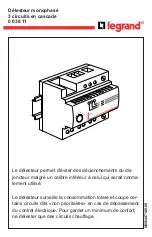
2-8
UR SERIES – COMMUNICATIONS GUIDE
FILE TRANSFERS
CHAPTER 2: MODBUS COMMUNICATION
2
The Oscillography Number of Triggers register increments by one every time a new oscillography file is triggered (captured)
and cleared to zero when oscillography data is cleared. When a new trigger occurs, the associated oscillography file is
assigned a file identifier number equal to the incremented value of this register; the newest file number is equal to the
Oscillography_Number_of_Triggers register. This register can be used to determine if any new data has been captured by
periodically reading it to see if the value has changed; if the number has increased then new data is available.
The Oscillography Number of Records register specifies the maximum number of files (and the number of cycles of data
per file) that can be stored in memory of the relay. The Oscillography Available Records register specifies the actual
number of files that are stored and still available to be read out of the relay.
Writing “Yes” (i.e. the value 1) to the Oscillography Clear Data register clears oscillography data files, clears both the
Oscillography Number of Triggers and Oscillography Available Records registers to zero, and sets the Oscillography Last
Cleared Date to the present date and time.
To read binary COMTRADE oscillography files, read the following filenames:
OSCnnnn.CFG
and
OSCnnn.DAT
For all products except C70, G30, and L30, replace “nnn” with the desired oscillography trigger number. And ASCII format,
use the following file names:
OSCAnnnn.CFG
and
OSCAnnn.DAT
2.3.1.5 Reading data logger files
Familiarity with the data logger feature is required to understand this description. See the Data Logger section of chapter 5
in the Instruction Manual for details. To read the entire data logger in binary COMTRADE format, read the following files.
datalog.cfg
and
datalog.dat
To read the entire data logger in ASCII COMTRADE format, read the following files.
dataloga.cfg
and
dataloga.dat
To limit the range of records to be returned in the COMTRADE files, append the following to the filename before writing it:
•
To read from a specific time to the end of the log: <space> startTime
•
To read a specific range of records: <space> startTime <space> endTime
•
Replace <startTime> and <endTime> with the number of seconds since Jan. 1 1970 as numeric text
2.3.1.6 Reading event recorder files
To read the entire event recorder contents in ASCII format (the only available format), use the following filename:
EVT.TXT
To read from a specific record to the end of the log, use the following filename:
EVTnnn.TXT
(replace nnn with the desired starting record number)
To read from a specific record to another specific record, use the following filename:
EVT.TXT xxxxx yyyyy
(replace xxxxx with the starting record number and yyyyy with the ending record number)
Memory mapping
2.3.1.7 Reading fault report files
Fault report data has been available via the UR file retrieval mechanism since UR firmware version 2.00. The file name is
f
aultReport#####.htm
. The ##### refers to the fault report record number. The fault report number is a counter that
indicates how many fault reports have ever occurred. The counter rolls over at a value of 65535. Only the last ten fault
reports are available for retrieval; a request for a non-existent fault report file will yield a null file. The current value fault
report counter is available in "Number of Fault Reports" Modbus register at location 3020h.
For example, if 14 fault reports have occurred then the files
faultReport5.htm
,
faultReport6.htm
, up to
faultReport14.htm
are available to be read. The expected use of this feature has an external master periodically
polling the "Number of Fault Reports' register. If the value changes, then the master reads all the new files.
The contents of the file is in standard HTML notation and can be viewed via any commercial browser.
Summary of Contents for UR series
Page 5: ...TABLE OF CONTENTS UR SERIES COMMUNICATIONS GUIDE v INDEX...
Page 6: ...vi UR SERIES COMMUNICATIONS GUIDE TABLE OF CONTENTS...
Page 20: ...1 14 UR SERIES COMMUNICATIONS GUIDE FOR FURTHER ASSISTANCE CHAPTER 1 INTRODUCTION 1...
Page 216: ...2 196 UR SERIES COMMUNICATIONS GUIDE MEMORY MAP CHAPTER 2 MODBUS COMMUNICATION 2...
Page 428: ...A 2 UR SERIES COMMUNICATIONS GUIDE REVISION HISTORY APPENDIX A MISCELLANEOUS A...
















































